
It’s all about controlling your acetylcholine levels this way…
—-Important Message From Our Sponsor—-
Copy what I do — get your wife or girlfriend squirting tonight

It’s easier than you may realize…
Do this exactly and watch as she transforms before your eyes…
All you have to do is copy one of these techniques to get her squirting tonight
———-
How to avoid a cognitive crash and protect a young mind and memory
Enhancing acetylcholine levels in the brain is a worthwhile pursuit, as this would be expected to enhance cognition.
Yet studies also show that too much acetylcholine release at once can actually deplete the storage form of the neurotransmitter.
It’s been suggested that acute cholinergic stimulation, in the absence of metabolic precursors, could eventually lead to a “cognitive crash.”
Acetylcholine is made directly from phosphatidylcholine, a cell membrane lipid that is used-up at the expense of its formation.
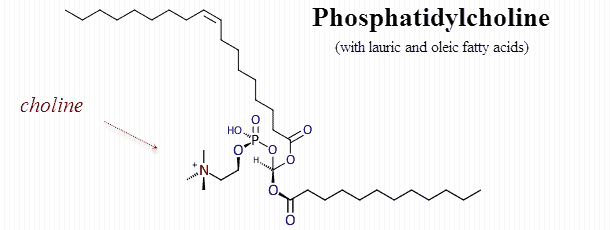
So without ongoing replenishment, an enhanced acetylcholine release can lead to the depletion of phosphatidylcholine and the very substance of the cell membrane itself.
Yet by having enough of the right metabolic precursors we can avoid this burnout/atrophy stage.
We can prolong mental activity for hours, perhaps days, thereby delaying that recovery phase where we find ourselves incapable of productive thought.
‘When the slices were superfused with a choline-free solution, their total phospholipid contents declined at the rate of 2.7% per stimulation period.’ ― Ulus
There are two separate molecular pathways leading to phosphatidylcholine: The Kennedy and the Bremer Pathways.
The Bremer Pathway creates new phosphatidylcholine using phosphatidylserine, and is significant, yet dietary choline can also be added directly to phospholipids using cytidine (or its uridine precursor).
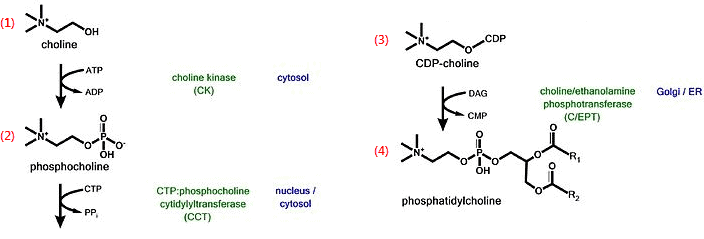
That is the Kennedy Pathway: This process stores food-derived choline as cell membrane phospholipids, and also recycles what was previously used for neurotransmission.
After acetylcholine is split into its two components by cholinesterase enzymes, free choline is still available and can be restored as a phospholipid before being eliminated.
Yet for this ongoing regeneration to occur we need uridine, a nucleotide readily converted into uridine triphosphate (UTP) once inside the cell.
From that point on, UTP then becomes slightly modified into cytidine triphosphate (CTP) and conjugated with phosphocholine.
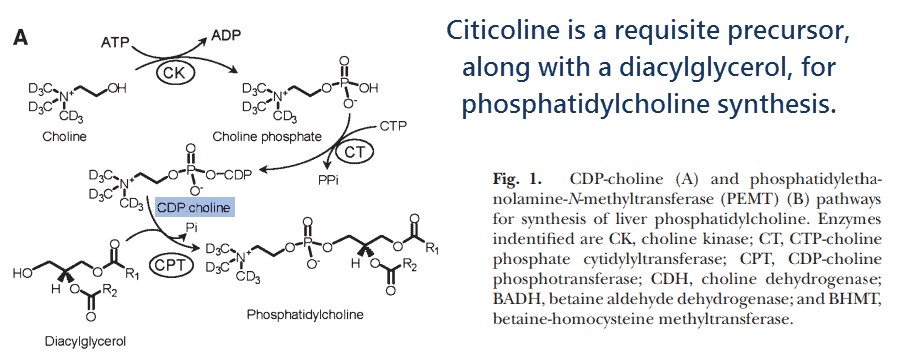
Two phosphate groups are eliminated in the process so the product is CDP-choline, or citicoline, and not cytidine tetraphosphate as implied by addition.
Citicoline is both a natural metabolite and a classic treatment used for treating dementia and stroke with a highly established efficacy in both conditions.
Yet newer studies have shown that CDP-choline does not enter the brain, as such, but is initially separated into cytidine and choline during the absorption phase.
And in addition to that change, all free cytidine is then quickly transformed into uridine by deamidase enzymes in the liver and/or intestines.
So the result is that free uridine and free choline, as separate entities, are what actually enter the brain upon taking citicoline.
You could consider these two metabolites as being the real active agents, a view that implies taking CDP-choline (citicoline) is tantamount to taking uridine monophosphate & eating a high-choline meal.
Although this extra choline could be helpful, most people already eat plenty, and studies suggest that uridine monophosphate (UMP) is just as capable of increasing brain phosphatidylcholine.
And uridine also has another beneficial effect distinct from the Kennedy pathway: uridine diphosphate and UTP are both ligands of P2Y receptors in the brain.
Activation of neuronal P2Y receptors releases inositol triphosphate (IP3) within the cell.
This induces a liberation of internal calcium stores, thereby activating CREB and increasing dendritic growth — i.e. “branching.”
These receptors are very similar to adenosine receptors — those which caffeine works on — and are in fact synonymous with P1 receptors.
‘Note that it has been recommended that “P1 receptor” and “P2 receptor” replace the “P1/P2-purinoceptor” terminology (Fredholm et al., 1996). The terms “adenosine receptor” and “P1 receptor” are synonymous.’ ―Ralevic
Some nucleotide receptors are activated by purines, some by caffeine and theophylline, and at least three others by uridine.
The P2Y4 and P2Y6 receptors are the uridine-specific receptors, while the P2Y2 receptor has dual-affinity between UTP and ATP.
The Kennedy Pathway and P2Y2/4/6 receptors are the two things which underlie the ‘nootropic’ actions of citicoline & uridine monophosphate.
These two actions are essentially the justifications used when categorizing uridine monophosphate as a “nootropic agent,” and also why citicoline has been so successful clinically in treating dementia.
Alzheimer’s disease is characterized by a low expression of nicotinic acetylcholine receptors, and aberrations in these have been correlated to disease severity.
So whether you intend on staving off dementia or simply increasing brain power, uridine monophosphate is certainly something worth considering.
Here is the evidence:

This classic study had shown ingesting citicoline is ultimately equivalent to ingesting uridine and choline, both separately, which are the two metabolites formed during assimilation.
Perhaps most surprisingly, plasma concentrations of cytidine had been undetectable after taking CTP-choline:
‘Cytidine levels failed to attain twice blank values, indicating that actual cytidine concentrations must have been less than 100 nM.’ ―Wurtman
Before this point citicoline had been shown liable to hydrolysis in the rat, which forms cytidine and choline, yet since humans use uridine as the circulating form there remained some uncertainty.
The two nucleotides are also difficult to resolve chromatographically being so similar, and are difficult to discriminate by most methods.
Using a more sophisticated technique these researchers showed that, in humans at least, citicoline is not only hydrolyzed into free cytidine and choline but that cytidine is rapidly converted into uridine.
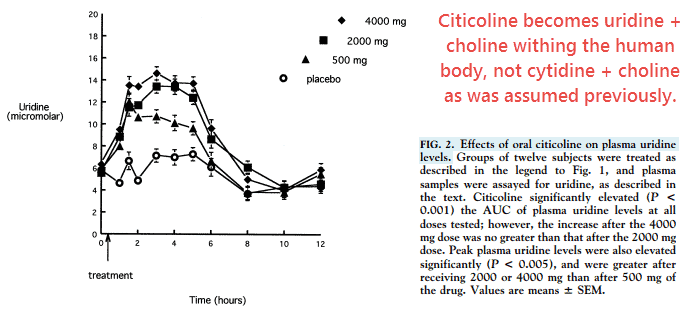
This implies that a person only has to take uridine monophosphate and eat a high-choline diet to obtain the established benefits of citicoline.
Uridine monophosphate could be ideal for many because it’s cheaper, and also because too much peripheral choline can actually be problematic.
Although choline is great in the brain, it can also be used to make platelet-activating factors in the bloodstream.
So choline is perhaps not the best thing to have in elevated amounts.
To get enough uridine via citicoline would mean ingesting a great deal, and this would of course add to whatever is normally obtained through diet.
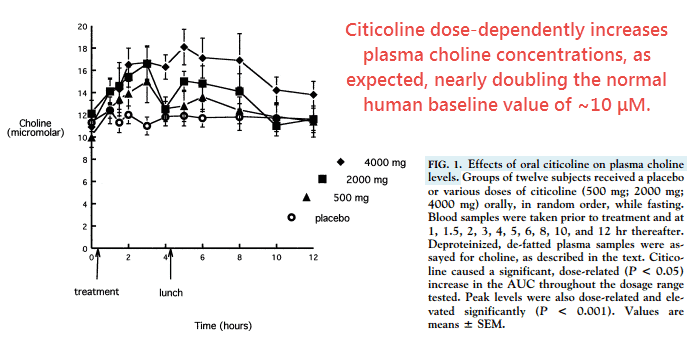
So on the basis of the study you could infer that taking uridine monophosphate would increase brain phosphatidylcholine levels, via the Kennedy cycle…
Which would prevent acetylcholine depletion by increasing the lipid-incorporation & recycling rates of choline.
And yet, there is really no need to speculate as this had been proven five years later by one the same researchers (Richard Wurtman):
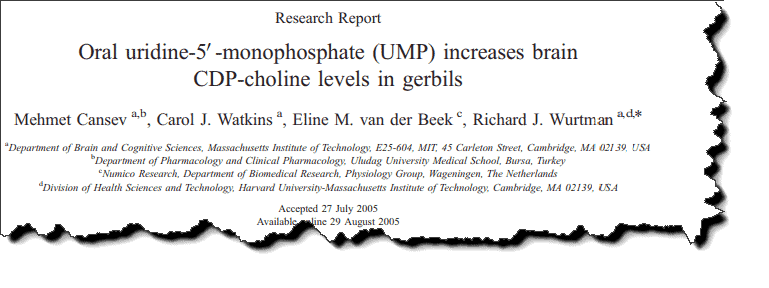
Mongolian gerbils had been used in this study because their metabolism more closely matches that of humans in this regard.
Gerbils normally have a greater uridine concentration than cytidine, in direct opposition to many species including the commonly used rat.
The dose they’d used increased plasma uridine levels sevenfold, and although there was some peripheral conversion to cytidine that hadn’t quite doubled.
In the brain, however, uridine concentrations increased fourfold and that of cytidine threefold.
So as expected, uridine had mostly remained uridine in the bloodstream but had converted into cytidine once inside the brain.
Oral uridine monophosphate increased UTP and CTP in the brain to roughly the same extent and concentrations of CTP-choline had nearly doubled.
This is the “Kennedy cofactor,” also synonymous with citicoline.
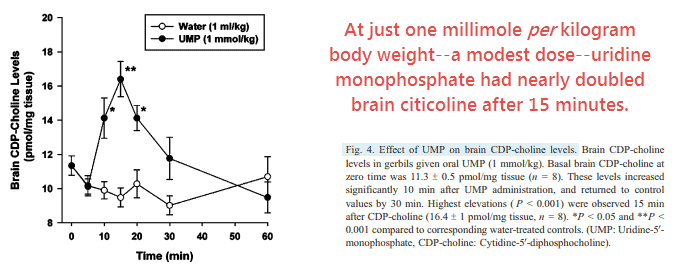
Oral citicoline will also work yet will be broken down into free uridine and free choline upon absorption.
Only afterwards will it be reformulated into citicoline when inside the brain.
Uridine monophosphate is cheaper than citicoline, and its use also avoids the liability of excessive plasma choline.
Brain CTP-choline is important because this catalyzes the formation of new phosphatidylcholine for cell membranes, the storage form of acetylcholine.
This metabolite even catalyzes the reuse of free choline before being eliminated.
It has been proven that phosphatidylcholine is: (1) the direct precursor of acetylcholine, and also that (2) it’s used-up in the process of its formation.
These two facts, when taken together, suggest that a high choline-reincorporation rate would help prevent acetylcholine depletion from occurring.
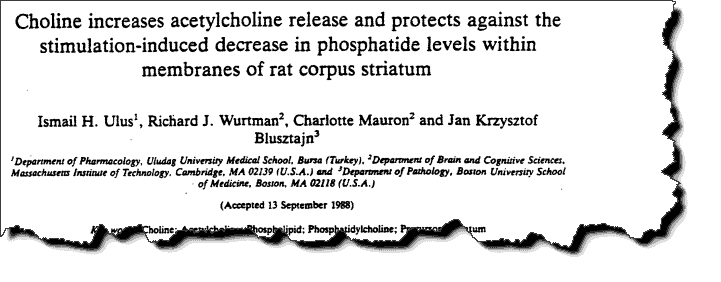
These researchers stimulated brain slices with electric current and measured acetylcholine released.
This technique is perhaps not that unphysiological as any method of membrane depolarization, in general, will do this.
High concentrations of extracellular potassium also depolarize the cell and also release acetylcholine.
This study confirmed that phosphatidylcholine was indeed the direct precursor for acetylcholine, the “storage form,” and also that it’s depleted in the process:
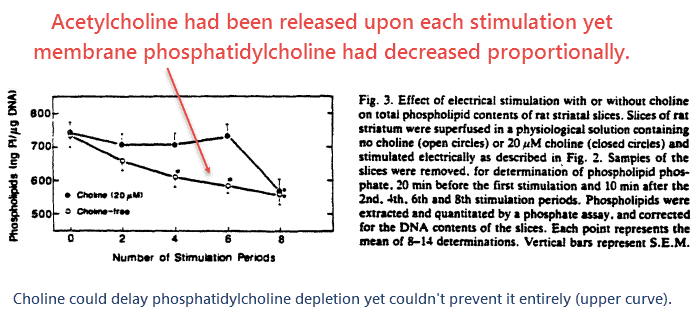
So simply a high-choline diet is not necessarily a guarantee of high brain acetylcholine, at all times.
Every other cofactor and enzyme involved in maintaining the cholinergic system also need to be present, and in addition to choline we also need thiamine to create acetyl groups.
Folate and vitamin B12 act in tandem to create and distribute methyl groups for choline, which may be significant when dietary sources are in short supply.
For such reasons: thiamine, folate, and vitamin B12 are the three vitamins most associated with dementia.
‘When the slices were superfused with a choline-free solution, their total phospholipid contents declined at the rate of 2.7% per stimulation period.’ ― Ulus
And uridine and/or cytidine are important as catalysts of choline transport.
It’s been known for over half a century that CTP-choline and diacylglycerol are the two precursors for phosphatidylcholine, with nothing else besides shown capable of accomplishing the task.
And uridine diphosphates (UDP) and triphosphates (UTP) are natural ligands of P2Y2/4/6 receptors.
It has been shown that uridine translates into increased growth in all cells expressing these receptors, brain cells not excluded.

This study had shown PC12 cells previously stimulated with nerve growth factor would increase branching in response to added uridine triphosphate (UTP).
This had been a dose-dependent effect, one in which the authors had explained through both the Kennedy Pathway and P2Y2/4/6 receptors.

Although a person could rightly imagine that intracellular uridine is doing this through phosphatidylcholine synthesis, there are a few lines of reasoning that suggest P2Y receptors are largely responsible.
First of all, apyrase was shown to almost completely eliminate this effect. Apyrase is an extracellular enzyme that hydrolyzes UDP and UTP, thereby preventing these from activating cell membrane receptors.
This treatment should not affect anything which happens INSIDE the cell, or whatever isn’t a direct effect of P2Y2/4/6 receptor activation.
Uridine metabolites are not destroyed by apyrase and it should not prevent them from entering the cell.
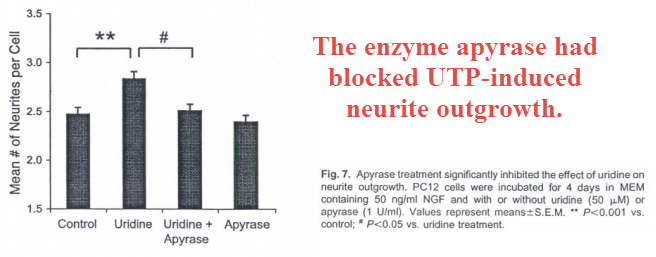
These cells also stained positive for P2Y2, P2Y4, and P2Y6 receptors.
The researchers also showed that neurite outgrowth could be blocked by employing antagonists of these receptors.
And moreover, adenosine and guanosine — the two purine nucleotides — have been shown to have the same effect on some neurons.
Caffeine and theophylline, two adenosine receptor ligands, have also been found to do likewise.
Adenosine is in no way responsible for phosphatidylcholine synthesis, so the effects it has on neurite outgrowth cannot be thought of as its result.
Incidentally, adenosine triphosphate was once thought as the cofactor for phosphatidylcholine synthesis before the supposed “necessity” was shown due to an impurity.
The impurity in crude ATP extract responsible for this, as you may have guessed, was cytidine triphosphate.
This anabolic effect on brain cells was also shown to occur in aging rats after the long-term intake of 2.5% uridine monophosphate in food.
So uridine monophosphate is a “nootropic agent” that works in two radically distinct ways:
This is the nucleotide needed for de novo synthesis of phosphatidylcholine, after conversion into CTP, and it’s also the prime activator of P2Y4 and P2Y6 receptors.
I wouldn’t expect to notice any effects right away but after diligently taking this for a few weeks, you could notice greater stamina stemming from high phosphatidylcholine levels.
It could also enhance creativity on account of neurite outgrowth, although it is difficult to speculate on the precise result of such an effect.
For a more immediate action a person could take a cholinesterase inhibitor, such as huperzine or galantamine, a treatment class that works by preventing the breakdown of the acetylcholine already formed.
Alternatively, treatments that activate acetylcholine receptors can also be used. Nicotine is the best known treatment in this class, and is such a good ligand that nicotinic acetylcholine receptors were named in its honor.
Galantamine is unique in that it’s both a cholinesterase inhibitor and an activator of acetylcholine receptors — naturally combining the power of both types of treatments.
Glutaminergic treatments, e.g. piracetam and pyroglutamate, are also popular.
Both of these liberate intracellular calcium, increase cerebral blood flow, and enhance cognition.
—-Important Message For Boosting Brain Blood Flow—-
This super vitamin C is better than any other type of vitamin C — can boost blood flow and more

When men take normal vitamin C, it only stays in the bloodstream for a few minutes.
But when men take SUPER vitamin C, it stays in the bloodstream for HOURS…
And it penetrates the tissues, the organs, the glands, and even the brain.
So this new SUPER vitamin C delivers more health benefits than regular vitamin C, and it can make men virtually immune to disease.
Here are some examples of how Super C is better than regular Vitamin C:
- Naturally improves blood flow ALL over the body
- Keeps your heart healthy so you don’t have to worry about heart disease…
- Fixes swollen aching joints…with Super C you can start golfing again or run in a 5K race…
- Protects memory and thinking power…now you no longer need to write everything down to remember it…
- Prevents infections and disease — no more colds, flus, or viruses
- Stops cancer in its tracks…potentially life-saving…
Here’s how to get this new SUPER vitamin C today (and it’s free).
———-
